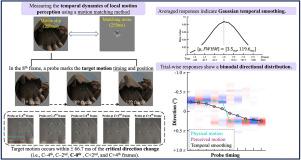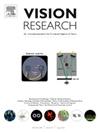Temporal dynamics of perceived motion flow in naturalistic movie sequences
IF 1.4
4区 心理学
Q4 NEUROSCIENCES
引用次数: 0
Abstract
To visualize the temporal dynamics of human visual motion perception under conditions close to everyday life, we measured the time course of the perceived motion vector when the observers viewed naturalistic movie clips that featured large direction changes of target objects. The spatiotemporal position of the target’s local motion was probed by a flashing dot that appeared within the range of ± 66.7 ms from the direction change. Observers had to report the perceived local motion using a motion vector matching method. The results show that the deviation of the perceived flow from the physical ground truth increased when the probe was presented near the direction changes. The pattern of errors averaged across multiple trials could be described by a Gaussian temporal smoothing of the local motion vectors, with a window size spanning about 120 ms. The results are consistent with previous reports of the sluggish temporal response of visual motion processing revealed by artificial stimuli and different tasks. However, a detailed examination of the response of each trial of our data indicated that the observers did not report a gradual transition from pre-change to post-change vectors but reported either of the two directions in a bimodal fashion with gradually changing response rates over time. This suggests that even though the motion processing may be sluggish, human observers correctly recognize a sudden direction change as a sudden event, not as a gradual transition.

自然主义电影序列中感知运动流的时间动态
为了可视化接近日常生活条件下人类视觉运动感知的时间动态,我们测量了观察者在观看具有目标物体大方向变化的自然电影片段时感知运动矢量的时间过程。目标局部运动的时空位置由一个闪烁点探测,该闪烁点出现在距离方向变化±66.7 ms的范围内。观察者必须使用运动向量匹配方法报告感知到的局部运动。结果表明,当探头靠近方向变化点时,感知到的流动与物理地面真实值的偏差增大。多次试验平均误差的模式可以用局部运动向量的高斯时间平滑来描述,窗口大小约为120 ms。这一结果与先前关于人工刺激和不同任务所揭示的视觉运动加工的缓慢时间反应的报道相一致。然而,对我们的数据的每个试验的反应的详细检查表明,观察员没有报告从变化前到变化后向量的逐渐过渡,而是以双峰方式报告两个方向中的任何一个,随着时间的推移反应率逐渐变化。这表明,即使运动处理可能是缓慢的,人类观察者也能正确地将突然的方向变化视为突然事件,而不是渐进的转变。
本文章由计算机程序翻译,如有差异,请以英文原文为准。
求助全文
约1分钟内获得全文
求助全文
来源期刊

Vision Research
医学-神经科学
CiteScore
3.70
自引率
16.70%
发文量
111
审稿时长
66 days
期刊介绍:
Vision Research is a journal devoted to the functional aspects of human, vertebrate and invertebrate vision and publishes experimental and observational studies, reviews, and theoretical and computational analyses. Vision Research also publishes clinical studies relevant to normal visual function and basic research relevant to visual dysfunction or its clinical investigation. Functional aspects of vision is interpreted broadly, ranging from molecular and cellular function to perception and behavior. Detailed descriptions are encouraged but enough introductory background should be included for non-specialists. Theoretical and computational papers should give a sense of order to the facts or point to new verifiable observations. Papers dealing with questions in the history of vision science should stress the development of ideas in the field.
 求助内容:
求助内容: 应助结果提醒方式:
应助结果提醒方式:


